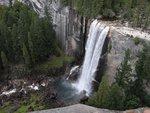Lighting Caused Fire in Yosemite National Park Continue to Burn
Date: August 12, 2011
Fire Being Managed for Multiple Objective; Fire at 715 Acres
On Sunday, July 31, 2011, Yosemite National Park experienced several lighting caused fires. Several fires were suppressed and one fire, the Avalanche Fire, is currently being managed for multiple objectives. The fire is located in the Avalanche Creek drainage, near the Glacier Point Road, within designated wilderness. The fire is currently at 715 acres and continues to be managed for multiple objectives, including resource values, community protection, and firefighter safety. Yosemite experienced higher than average precipitation during the 2010-11 winter season. The spring and summer season has been relatively cool, providing high fuel moistures, and continued late snowmelt. These conditions provide opportunities for Yosemite Fire Crews to treat hazardous fuels in the park.
Yosemite is currently working with the Mariposa County Air Pollution Control District (MCAPCD) to monitored air quality impacts, mitigations, and public health concerns. Air monitoring equipment has been installed within the communities of Yosemite West, El Portal and Yosemite Valley to record daily air quality levels. Fire crews will monitor air quality dispersion and smoke impacts throughout the weekend, utilizing improving atmospheric conditions to minimize smoke impacts to air quality and surrounding communities.
“We are pleased to be able to work with MCAPCD to mitigate health impacts from smoke while still managing a large wildfire,” stated Yosemite Fire Management Officer Kelly Martin. “We are working to manage near term smoke, as well as, address future smoke emissions. Without reducing hazardous fuels future large fires, associated high pressure systems, high temperatures, or poor dispersion would create more pronounced adverse impacts.”
“The Mariposa County Air Pollution Control District understands the use of fire for the health of the forest and for the safety and protection to communities. But the Air District’s primary responsibility is to protect public health and minimize the adverse health effects of smoke to heart and lungs. The APCD is, therefore, taking a cooperative approach to achieve the goals essential to each agency without compromising health due to excessive smoke. The permit with conditions which the District issued to the park is consistent with this approach,” according to Dr. Mosher, MD., Mariposa County Public Health Officer and Air Pollution Control Officer.
Yosemite Fire Crews will remain along the Glacier Point Road to continue to monitor the fire. Smoke from the Avalanche Fire is visible along the Glacier Point Road, portions of the Wawona Road (Highway 41), the Big Oak Flat Road (Highway 120), the El Portal Road (Highway 140), and multiple locations throughout Yosemite. Lightning caused wildland fires frequently occur during the summer months in Yosemite. Fire is a natural part of the Sierra Nevada ecosystem, which has shaped the forest landscape for thousands of years. Managing naturally occurring lightening fires is consistent with the current Yosemite Fire Management Plan and Environmental Impact Statement.
For more information about the fire management program and the Avalanche Fire in Yosemite National Park, please visit http://www.nps.gov/yose/parkmgmt/current_fire.htm. For Air Quality monitoring, please visit http://www.nps.gov/yose/naturescience/aqmonitoring.htm.
Lighting Caused Fire in Yosemite National Park Continues to Burn
All posts are those of the individual authors and the owner
of this site does not endorse them. Content should be considered opinion
and not fact until verified independently.
Sorry, only registered users may post in this forum.


